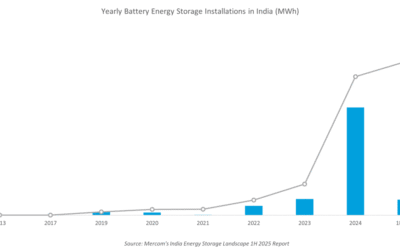Image: Navigant.
Software for energy storage systems will be a mixture of in-house solutions by integrator/developers and third-party providers, in an industry segment set for a steep rise in value, according to one expert.
A new report from Navigant Research has predicted a steep rise in the value of energy storage software. Navigant analyst Alex Eller told Energy-Storage.News that cumulative vendor revenues will rocket from US$201.2 million this year to US$3.4 billion by 2025. The report itself looks at both utility-scale and behind-the-meter energy storage software, including residential, commercial and industrial (C&I) and large-scale, from a range of providers with a range of approaches.
Software is a vital piece of the advanced energy storage puzzle, used in three key areas: analysing projects, controlling and operating storage systems, and system optimisation. As Eller points out, software determines how effectively the storage will achieve revenues or savings, whether that be in helping C&I customers reduce demand charges on their bills or providing multiple or ‘stacked’ services to grid operators.
While on the one hand the right software can effectively manage and control systems, it also plays its role even before systems are built.
Enjoy 12 months of exclusive analysis
- Regular insight and analysis of the industry’s biggest developments
- In-depth interviews with the industry’s leading figures
- Annual digital subscription to the PV Tech Power journal
- Discounts on Solar Media’s portfolio of events, in-person and virtual
“Usually a lot of the same vendors that have management systems platforms also do system design and analysis,” Eller said.
“So before anything even gets built they can model how components are going to interact, the optimal size for the system and all different operating parameters that are going to allow streamlined installation, make the whole process faster and more accurate, you’re not going to have systems that are oversized or undersized, theoretically that’s the idea there.”
According to Eller, two big challenges facing the energy storage market are the high upfront costs for systems and a lack of education among customers and other stakeholders including regulators on the benefits the technology can provide.
“Software platforms can help tackle both challenges for system vendors and developers,” Eller said.
Third-party providers versus in-house solutions
The report details market and technology issues, as well as profiling 19 key players in the industry, including the likes of Stem and Green Charge in C&I, Doosan Gridtech and Younicos at utility-scale and Sonnen and Sunverge at residential.
While the majority of companies profiled are storage manufacturers or project system integrators that have their own in-house software solutions, Alex Eller of Navigant believes that third-party software providers such as Greensmith will have some key sets of customers to turn to as storage takes off.
“[There are] different views on the advantages, disadvantages to companies having their own platforms versus working with third parties but I think as things evolve, there’ll be more opportunities for the pure software providers,” Eller said.
“Utilities are going to start building storage for themselves rather than contracting with companies like RES, for example to build that for them and in that case they’re going to become customers for software [providers].”
Eller said wind and solar developers were likely to start also building their own storage projects, forming another customer base for pure-play software companies.
Aggregation and virtual power plants are the coming trend
Navigant’s report looks at the global industry focusing primarily on North America, Europe and Asia – with more emphasis on the former two, purely due to the majority of activity being concentrated in these two regions.
Looking forward, one of the big trends in energy storage is the growing aggregation of systems, including virtual power plants – coordinating large numbers of behind-the-meter assets to act in concert as one larger resource. Eller identified this as another area where software plays a key role in balancing the sometimes competing, sometimes complimentary sources of generation and load management that feed into virtual power plants.
“Even today, most of the systems [deployed] are kind of doing their own thing, operating individually, but that’s really one of the big trends right now, even if it’s really for the most part pilot projects and much less activity for large-scale aggregation and coordination of systems, that’s really the biggest change we’ll see.”
Virtual power plants have over the past year or so started gaining headlines around the world, including Green Charge announcing a 13MWh project in New York made up of connected residential and commercial systems, and Eller says the concept has taken off more quickly than people had anticipated.
Differentiation and competition
Hardware vendors in energy storage are bracing themselves for tough competition over the coming years, with some anticipating a ‘bloodbath’ of consolidation and price wars. Eller said there will be a key difference when it comes to competition in the software space.
“I don’t think it will be quite as competitive, at least in terms of decreasing prices,” Eller said.
“We did some forecasts on how much people are charging for these platforms and we don’t see it decreasing anything like what we’ve seen for batteries – but we still have quite a lot of competition. A lot of the software providers are trying to not do the kind of race to the bottom decrease prices as quickly as possible and position it more as if they want to be a ‘premium’ software that has a lot of additional value, rather than get it out there as cheaply as possible.”
From a customer’s point of view however, only the tip of the iceberg might be visible. While different software makers might tout the quality of their product, from a customer perspective, it will be a case of looking at the software company’s track record of getting storage products working, and the revenues and savings they might enable.





